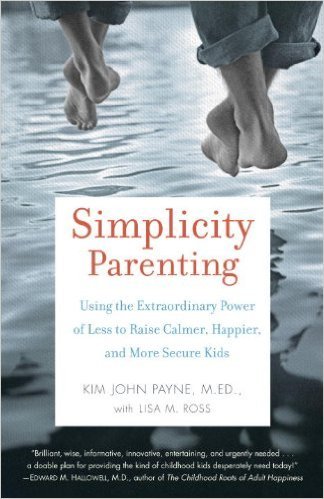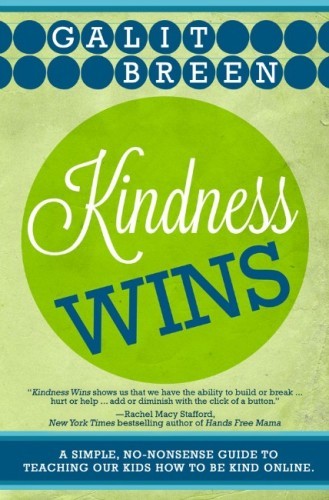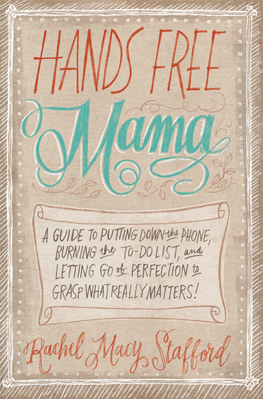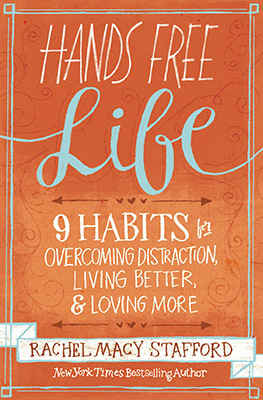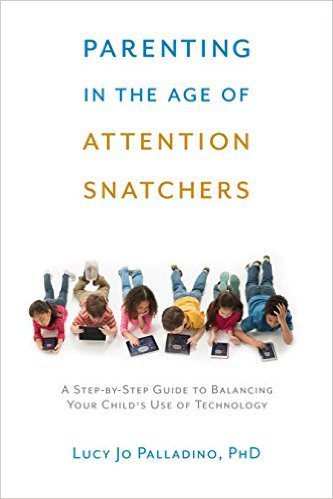Katrina Kenison's Blog, page 7
February 16, 2016
saving Jake — a mom’s story & a give-away
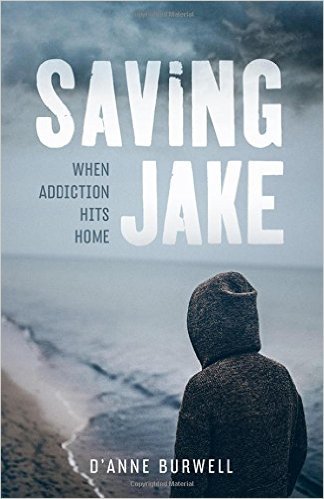 Since writing last week about my son Jack’s addiction and first steps in recovery, I’ve been inspired and humbled and deeply moved by the stories so many of you have shared, both here on the website and in private emails. This conversation, still ongoing, is a beautiful, necessary reminder that we are all connected — not only by our struggles but also in our hope for our loved ones and in our compassion for one another’s challenging, complicated journeys.
Since writing last week about my son Jack’s addiction and first steps in recovery, I’ve been inspired and humbled and deeply moved by the stories so many of you have shared, both here on the website and in private emails. This conversation, still ongoing, is a beautiful, necessary reminder that we are all connected — not only by our struggles but also in our hope for our loved ones and in our compassion for one another’s challenging, complicated journeys.
Our culture is obsessed with perfection – and with hiding our problems. But what a liberating thing it is to realize that our private battles are, in fact, universal. And that they are also our richest opportunities for being able to fully share in both the grief and the joys of others.
And so, in that spirit of compassion, I would like to share with you an intimate, courageous book that made a profound impression on me.
Last May a reader of The Gift of an Ordinary Day wrote to say that my book had been “a balm” to her “roughened mother’s soul.” D’Anne went on to reveal that she’d come to cherish life’s quiet, mundane moments by way of a different path: “My 23-year-old son is three years clean from Oxy and heroin.”
D’Anne has written about her family’s experience in a profoundly revealing, quietly instructive memoir called Saving Jake: When Addiction Hits Home. As she explains, “Too few books have been written by parents battling the disease of addiction, while meanwhile an epidemic of prescription drug abuse leading to heroin in our youth rages on.”
I will admit that I read much of this utterly harrowing, ultimately heartening book through tears. Tears of recognition. Tears of empathy. Tears that came simply from knowing, “There but for the grace of God go I.”
I will also admit that once I started, I couldn’t put Saving Jake down. D’Anne Burwell writes with a novelist’s gift for dialogue and detail. The result is a riveting story that held me in its grip even as it changed many of my assumptions about addiction and recovery.
And then there’s this: D’Anne could easily be my best friend — or yours. With every page, I thought how with a few different strokes of fate, her story could be my story, or any family’s story. In fact, it’s a story that’s unfolding in some variation right now in thousands of homes across the country.
Smart, engaging, athletic, Jake seems bound for success. When his grades begin to slip, when he withdraws from sports and his active family, his parents are concerned but realistic: teenagers need their space. And Jake is adept at coming up with one reasonable story after another. But it doesn’t take long for his life to spiral downward. Experiments with marijuana soon lead to OxyContin. Addicted to heroin within a year of leaving home for college, he drops out of school, walks out of rehab, and winds up homeless on the streets of Boulder.
I stood gripping my kitchen countertop, taking short panting breaths, feeling as if I’d been squeezed inside the darkest tunnel. My son’s lies and excuses had obscured that his life was falling apart. I’d suddenly strung it all together—the soot on his forehead, the hollowed-out Bic pens, the wadded up foil, the ruined finances. My nineteen-year-old son was addicted to OxyContin.
Struggling with fear, guilt, and a desperate desire to help her son, D’Anne must also confront new fissures in her marriage, her husband’s own anger and confusion, and their daughter’s depression. The disease of addiction affects them all, forever reshaping the dynamics of their close-knit family life.
Meanwhile, engaged in a fierce battle to save her child, D’Anne learns of the terrifying links between prescription drug abuse and skyrocketing heroin use among teenagers and young adults – kids from good backgrounds, solid families, and loving homes whose lives are nevertheless quietly, tragically spinning out of control.
Twice now I’ve watched my son spiral down into skin and bones, hollow eyes, and an empty soul. Powerlessness is tearing my heart apart.
With a flair for the quiet drama of real life, D’Anne Burwell traces each step of Jake’s journey from typical American high schooler to homeless addict who’s exhausted every option but one: the ultimate choice between life or death. And in the process she shares her own painful education as she comes to understand that to save her child she must step back and allow him to fight for his own soul.
As soon as I finished reading Saving Jake last spring, I brought the manuscript (as yet unpublished) over to a close friend whose own son is in recovery from heroin addiction. Taking the book from my hands she looked at me and asked, through sudden tears, “Does this boy live? Because I don’t think I can read this if he doesn’t.”
Jake is one of the lucky ones. He does live, but his survival is not a foregone conclusion. Many of our kids don’t make it. If you have teenagers in your life, you already know: these are confusing times and everyone is vulnerable. Life changes in a moment. Addiction is a disease. And no one is immune.
I do think that if every parent were to read this book, however, we would have a much better sense of what we’re up against. Our kids and our families might have a better chance. Knowledge is power, after all. And D’Anne Burwell has done a great deal of homework. Her brave, compelling book removes the shame and silence from addiction and brings the truth of this epidemic into clear focus. If your child is struggling, you will find companionship and comfort in these pages. And if you are struggling, D’Anne’s own journey of recovery will offer you a first-hand portrayal of what it means to detach with love.
In fact, the hard-earned wisdom of Saving Jake is a gift to anyone who has ever loved a child, harbored hope for another’s healing, or come to the hard realization that the only life we can save is our own.
enter to win a signed copy
Saving Jake was the 2015 USA BEST BOOK AWARDS winner in the category of Health: Addiction and Recovery. D’Anne Burwell has kindly agreed to sign two copies of her book, for two of my readers. To enter to win, simply leave a note in the comment section below. You can share a quote that has inspired you on your own journey. You can offer a reflection. Or you can just say “count me in.” Two winners will be chosen at random after 10 p.m. on Friday, February 26.
Want to read now? To order Saving Jake from Amazon, click here. (This is an Amazon affiliate link.)
The post saving Jake —
a mom’s story & a give-away appeared first on Katrina Kenison.
February 9, 2016
first steps
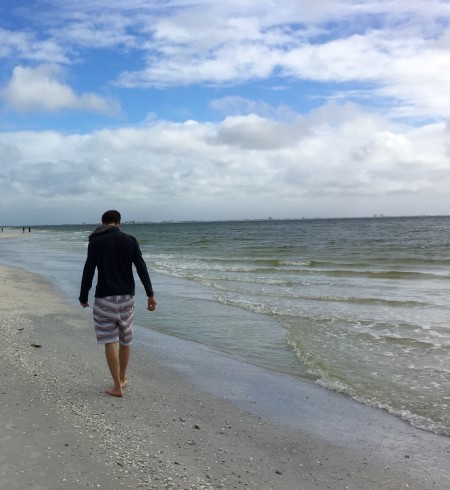 I just got off the phone with my son Jack. He touched in as he often does these days after school, to say hi, to tell me about the few questions he missed on a test, to let me know he’s going to AA tonight, where he’ll receive a 30-day sobriety chip.
I just got off the phone with my son Jack. He touched in as he often does these days after school, to say hi, to tell me about the few questions he missed on a test, to let me know he’s going to AA tonight, where he’ll receive a 30-day sobriety chip.
It’s been a month since Jack had a beer or used any other substance, 80 days since he last smoked pot, his drug of choice.
At 23, he is meeting his own sober adult self for the first time. In a way, so am I.
These have not been ordinary days. But in all my years as his mother, I have never been so proud.
A month ago, on his 50th consecutive day of not getting high, Jack told me he was going to write a status update on Facebook to share what he’d been going through. My first response was concern for him, for his privacy and for the fragility of his still-new sobriety.
“Think carefully before you do that,” I said. He already had. He’d led a double life for years. And he didn’t want to do it anymore. So he put it out there, for all to see:
These last couple months some things have happened for me that really forced me to step back and look at myself objectively. After countless past attempts and failures I have finally committed to confronting my deep-seated patterns of addiction. After today I will have successfully stayed sober for a full 50 days. This is the longest time for me since I began smoking weed when I was 15 years old. I am writing this status because the reason I fell into this pattern was because I neglected to be open and honest with people about how I was suffering, and instead opted to portray myself as someone who had all their shit together and was always happy and enthusiastic. The truth is I was so ashamed and guilty about how I could not control myself, that it was too frightening to let people see what was really going on. I can’t think of a better way to facilitate a change than by being honest right here on FB for everyone I know to see. So there it is. Thank you to every one of my friends who are supporting me through this drastic life change.
I’m not yet well versed in the twelve steps of recovery. But my sense is that these early days are a particularly vulnerable time – a kind of tender, bare-naked limbo between the old, ingrained ways of numbing and escaping and the delicate beginnings of new coping skills and healthy habits.
For Jack, a huge part of this process has been about stripping away the layers he’s hidden behind for years.
Smart, funny, creative, athletic, passionate, my son has always been a natural leader and a loyal friend. He has prevailed, almost effortlessly, in many areas of his life — on the pitching mound as a kid, on the tennis court in high school, in challenging AP classes, in the sound engineering program he’s now completing in Atlanta, and most recently in a physically and emotionally demanding job that requires deep commitment on his part.
At the same time, he’s lived another life, one he’s put enormous energy into keeping hidden from many who know and love him. There was the charismatic, easy-going, self-confident young man who could inspire a team to victory, improvise a guitar riff, or step out on a stage and juggle five balls without breaking a sweat. There was the nonchalant student who could always pull out a decent grade at the last minute. There was the defiant, impulsive teenager who acted first and regretted later. And there was someone else, too: a boy who found his own chaotic emotions too uncomfortable to bear, who numbed his feelings of inadequacy with hits of pot, who lied to cover up his feelings of weakness, who found himself increasingly powerless to live the life he dreamed of, and who felt like more of a fraud and a failure with each passing year.
In recent weeks, Jack and his dad and I have been engaged in a painstaking process of getting to the truth of things. A necessary reckoning, a first tentative step toward healing.
Hard as it was to look back on some of the darker moments of these last few years, we each wrote letters – raw, no-holds barred letters — that gave full voice to our memories, our worries, our fears. We let our true selves be seen, in all our sadness.
For his part, Jack gave us a full accounting. Coming clean was a step in his recovery; absorbing all he had to tell us was part of ours. None of it was easy.
But I can say this: each of us told the truth. Each of us listened. Each of us was heard. And dismantling the old walls, on both sides, was a relief. There was nothing more to separate us. And so we could reach right back out and touch each other again, for real — with love, with forgiveness, and with a commitment to move forward from here. Together.
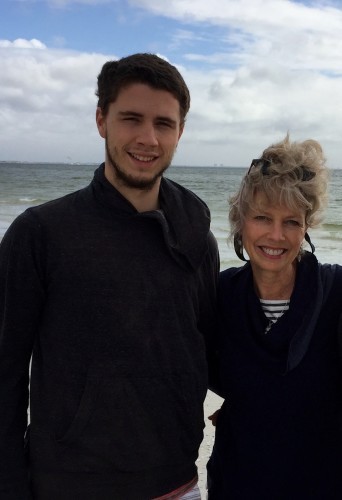 Truth, as Jack is discovering, is a powerful antidote to shame. It takes such courage to step out of hiding and be seen as we really are: imperfect, striving, hopeful, scared. And now he is widening the circle. With each new day of sobriety, with each 12-step meeting, with each conversation in which he shares his struggle, his network of support grows larger. Bit by bit, the loneliness and isolation that have been his secret prison are transformed — into both accountability and connection. But as my son reminds me every time we speak, it’s a slow, at times excruciatingly painful process.
Truth, as Jack is discovering, is a powerful antidote to shame. It takes such courage to step out of hiding and be seen as we really are: imperfect, striving, hopeful, scared. And now he is widening the circle. With each new day of sobriety, with each 12-step meeting, with each conversation in which he shares his struggle, his network of support grows larger. Bit by bit, the loneliness and isolation that have been his secret prison are transformed — into both accountability and connection. But as my son reminds me every time we speak, it’s a slow, at times excruciatingly painful process.
The other day, I suggested that hard as this is, he has much to be grateful for. “The thing I’m most grateful for,” he said, “is that I don’t hate myself anymore.”
Hearing the son I love so much speak those words nearly broke my heart. But it also made me think about the profound value of standing tall in all our vulnerability, allowing our deeply flawed, most authentic selves to be fully seen.
I can’t help but wonder how many other teenagers and young adults are living lives that look good on the outside, while suffering on the inside. I know there are many who can ride life’s ups and downs with ease, who can enjoy alcohol and marijuana without ill effects, who experiment with drugs without becoming dependent or addicted. But I also believe the fear of being not-enough, of being unlovable, of being inadequate runs deep through our culture. And no, a loving home and caring attentive parents are no guarantee against either inner suffering or self-harm. We are all wired for struggle, and some of us are wired for addiction. That is a battle no one can fight alone.
Jack has a long road ahead – recovery, as we know already, isn’t a destination but a lifelong journey. But he’s put his feet down on the path. He’s walking it. I can’t clear away the obstacles in front of him nor take on the work that’s his alone to do. I can be here, though, listening each day, sharing both his struggles and his victories. I can let him know how proud I am of his progress and of his courage. And, with Jack’s permission, I can follow his example by telling the truth, entrusting each of you reading this with the first chapter of his new story. Thank you for sharing this journey with us.
“Courage is a heart word. The root of the word courage is cor – the Latin word for heart. In one of its earliest forms, the word courage meant To speak one’s mind by telling all one’s heart. Over time, this definition has changed, and today, we typically associate courage with heroic and brave deeds. But in my opinion, this definition fails to recognize the inner strength and level of commitment required for us to actually speak honestly and openly about who we are and about our experiences — good and bad. Speaking from our hearts is what I think of as ordinary courage.” ― Brene Brown
The post first steps appeared first on Katrina Kenison.
January 13, 2016
things to love in january
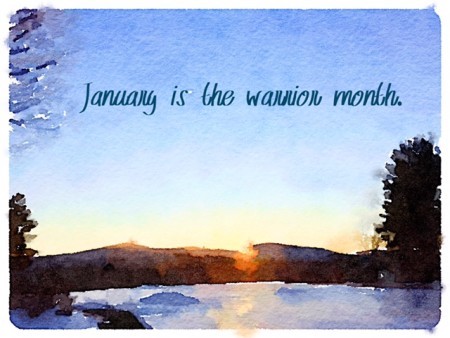 January is the warrior month,” writes Vivian Swift in her gorgeous hand-lettered book When Wanderers Cease to Roam: A Traveler’s Journal of Staying Put. She continues, “It takes a warrior to soldier through these cold, dark, harsh January days.”
January is the warrior month,” writes Vivian Swift in her gorgeous hand-lettered book When Wanderers Cease to Roam: A Traveler’s Journal of Staying Put. She continues, “It takes a warrior to soldier through these cold, dark, harsh January days.”
Indeed it does, especially for me this year. Maybe for you, too?
Well, even a peaceful warrior needs to be well armed. Here, a quick round up of my own best defenses.
Knowing I’d be mostly homebound and recuperating from surgery in January, hobbling around on crutches rather than trekking through the woods on my snowshoes, I decided to gird myself for the warrior month by creating a bit of structure for my days. The healing journey requires patience, but it’s also turned out to be an opportunity to enjoy some special treats for both body and soul.
Of course, you may simply be recuperating from the demands of life itself. Reason enough, certainly, to treat yourself! So do come along, and enjoy these simple pleasures with me.
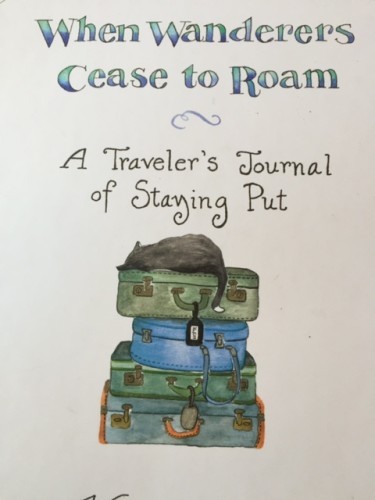 A friend sent me When Wanderers Cease to Roam before my first hip replacement in October: the perfect gift to uplift and inspire me as I settled into my new mindset of “staying put.”
A friend sent me When Wanderers Cease to Roam before my first hip replacement in October: the perfect gift to uplift and inspire me as I settled into my new mindset of “staying put.”
Following a lifetime of exploring around the globe and racking up twenty-three temporary addresses in twenty years, Vivian Swift finally landed for good in a small town on the edge of Long Island Sound. She spent the next decade quietly taking stock of her life, studying the view beyond her window, and reflecting on what it means to call a place home. The result is this enchanting, wholly idiosyncratic chronicle of a year of paying attention – an intimate and charming mish-mash of diary entries, watercolor paintings, recipes, quotes, poignant longings and astute observations.
I’ve already bought and given away four more copies of When Wanderers Cease to Roam. If you’ve ever yearned for life in the slow lane, if you’ve deliberately chosen deep roots over far-flung adventures, or even if you find yourself unwillingly homebound for a while, I can assure you: this is your book.
Some days ‘staying put’ might feel the same as Going Nowhere. Make a cup of tea and wait for that feeling to pass.” ~ Vivian Swift
Good advice. My tea of choice this month is chai, that warming, spicy Indian blend of black tea laced with cinnamon, black pepper, ginger, cloves, and cardamom. Sure, you can make your own. (My favorite recipe is here.) Or you can take a short-cut with one of these delicious and authentic organic blends. For tea bags, I like Nature’s Cuppa. When I’m brewing a pot to share or want to linger over a spicier cup, I use Chai-Wallah’s blend, created by a small family company in Vermont.
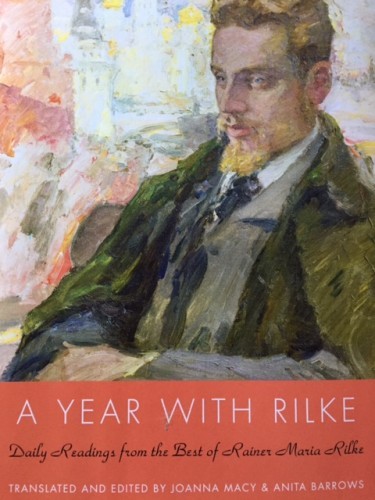 Without too much on my plate, I figured that January would be a perfect time to welcome a new habit into my life. I love the idea of beginning the day with a few good sentences rather than a scan through Facebook or a peek at the emails that arrived while I was asleep. A daybook makes it easy, with a reading for each day of the year. I bought two copies of A Year with Rilke, since sharing this daily reading journey with a friend doubles the pleasure. Rilke’s reflections on impermanence, the beauty of creation, the importance of solitude, the presence of the divine in daily life, all resonate deeply, especially now. Each morning I look forward to the few minutes I spend with this trusted guide who challenges me to think deeply and to be more fully present in my life. And as I learn to accept the truth of existence – that nothing lasts – Rilke reminds me that it takes a special kind of courage to love the things of this world anyway, without reserve, and to believe that praising them is our highest calling.
Without too much on my plate, I figured that January would be a perfect time to welcome a new habit into my life. I love the idea of beginning the day with a few good sentences rather than a scan through Facebook or a peek at the emails that arrived while I was asleep. A daybook makes it easy, with a reading for each day of the year. I bought two copies of A Year with Rilke, since sharing this daily reading journey with a friend doubles the pleasure. Rilke’s reflections on impermanence, the beauty of creation, the importance of solitude, the presence of the divine in daily life, all resonate deeply, especially now. Each morning I look forward to the few minutes I spend with this trusted guide who challenges me to think deeply and to be more fully present in my life. And as I learn to accept the truth of existence – that nothing lasts – Rilke reminds me that it takes a special kind of courage to love the things of this world anyway, without reserve, and to believe that praising them is our highest calling.
Praise, my dear one.
Let us disappear into praising.
Nothing belongs to us.”
~Uncollected Poems
It’s been over a year since I either taught or attended regular yoga classes. A year in which I’ve practiced diligently but mostly alone, giving myself a graduate level course in modifying my own practice, slowing down, working with the body that shows up on my yoga mat (often hurting, with much-reduced strength and flexibility), and learning to accept myself as I am, my practice as it is, pain as my teacher.
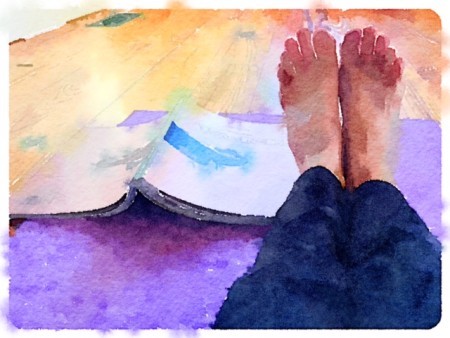 But. It’s January and I have two brand new hips. Happily, just as I was craving a bit of spice and some company on my mat, I discovered a lovely yoga teacher in Austin, Texas. And thanks to the wonders of technology and her extraordinary generosity in offering free online classes, I’ve become a daily student in Adriene’s 30-Day Yoga Camp. Whether you are new to yoga or a seasoned yogi, I’m pretty sure you’ll agree with me about Adriene: she is a joy to practice with. Sign up for her 30-day yoga camp and you’ll receive a daily email with a link to the day’s practice video, each of which is thirty-five minutes long. Miss a day? No problem, you can catch up (or skip a day) according to your schedule. It’s not too late to jump in! Visit Adriene’s website here, and click on Yoga Camp for more info.
But. It’s January and I have two brand new hips. Happily, just as I was craving a bit of spice and some company on my mat, I discovered a lovely yoga teacher in Austin, Texas. And thanks to the wonders of technology and her extraordinary generosity in offering free online classes, I’ve become a daily student in Adriene’s 30-Day Yoga Camp. Whether you are new to yoga or a seasoned yogi, I’m pretty sure you’ll agree with me about Adriene: she is a joy to practice with. Sign up for her 30-day yoga camp and you’ll receive a daily email with a link to the day’s practice video, each of which is thirty-five minutes long. Miss a day? No problem, you can catch up (or skip a day) according to your schedule. It’s not too late to jump in! Visit Adriene’s website here, and click on Yoga Camp for more info.
If you’re like me, you may have started the new year by clearing your online decks and getting rid of some of the non-essential reading that seems to pour into our in-boxes each day. That clears more space for what’s meaningful, essential.
One of the most moving pieces I’ve read lately is an essay by my friend Dani Shapiro about the lingering grief of a lost friendship, one that ended badly, in silence and secret hurt. We’ve all been there. The pain of a fractured relationship never really heals, but it does teach us something. It can make us kinder going forward, more empathetic, and perhaps more willing to have the conversations we don’t want to have.
I put Claudia Cummins’s exquisitely curated blog A First Sip in my “essential” category: each weekday’s poem or quote seems perfectly chosen to inspire me to pause, reflect, and reconnect to my own best self. So when Claudia offered readers an opportunity to receive a daily essay through the month of January, I signed up immediately.
“The Gift of the World: A New Year’s Immersion” is a series of brief, beautifully written daily readings that invite us to rekindle the “quiet light” within each of us. As Claudia observes, “The new year offers a perfect opportunity to reflect on the values, attitudes, and practices we hold most dear, and to reclaim space in our lives to nourish and nurture these loves.” These lovely essays — on subjects such as Rest, Kindness, Abundance, Beauty, and Attention – have been setting the tone for each of my January days. They are the perfect written complement to thirty days of yoga. And they’re also a much-needed reminder that I can choose to launch into this new year with a spirit of openness and abundance rather than focusing on what’s lacking, what I’m not, what I need to change.
You can still sign up to receive all of Claudia’s January offerings, here.
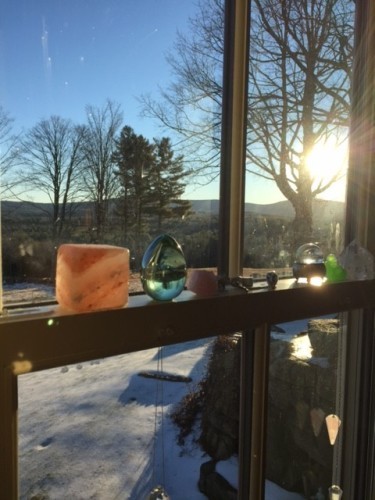 I tend to associate chapters of my life with the music I’m listening to. This winter, when everything from washing the dishes to doing my PT stretches takes an extra-long time, I’m playing more music in the house than usual, and I’ve got a pretty eclectic soundtrack evolving, everything from Sara Bareilles to Neil Young to Nina Simone to Ashana. Time to put together a new Alternatives-to-Adele (who I DO love) winter playlist on Spotify. In the meantime, you can click on the above artists’ names for a sampling of the music that’s filling my January days.
I tend to associate chapters of my life with the music I’m listening to. This winter, when everything from washing the dishes to doing my PT stretches takes an extra-long time, I’m playing more music in the house than usual, and I’ve got a pretty eclectic soundtrack evolving, everything from Sara Bareilles to Neil Young to Nina Simone to Ashana. Time to put together a new Alternatives-to-Adele (who I DO love) winter playlist on Spotify. In the meantime, you can click on the above artists’ names for a sampling of the music that’s filling my January days.
And now, I’d love to know: How are YOU surviving the warrior month? What are you reading? What are you listening to? What’s filling your cup?
P.S. I wish I could claim credit for these sweet watercolors, but alas no. I have been playing around with some cool apps, though. Waterlogue is one that can turn any photo on your phone into a painting. One more thing to love in January!
(The above books are Amazon Affiliate links.)
The post things to love in january appeared first on Katrina Kenison.
January 8, 2016
four lessons I learned from surgery
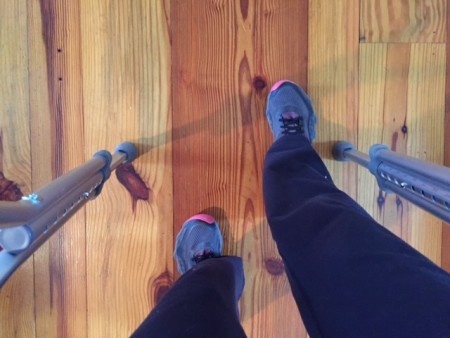 It’s been two and a half weeks since my second hip replacement, a bit more than two months since the first. And I’m finally approaching the moment when I can look back and say, “It was worth it.” As of a few days ago, I’m getting around the house on one crutch, which leaves a hand free for pouring tea or emptying the dishwasher. I can pull on my own compression socks and cut my toenails and drive downtown. Best of all, I can press up from all fours into a downward-facing dog.
It’s been two and a half weeks since my second hip replacement, a bit more than two months since the first. And I’m finally approaching the moment when I can look back and say, “It was worth it.” As of a few days ago, I’m getting around the house on one crutch, which leaves a hand free for pouring tea or emptying the dishwasher. I can pull on my own compression socks and cut my toenails and drive downtown. Best of all, I can press up from all fours into a downward-facing dog.
What I didn’t expect yesterday, as I spread my palms wide on my yoga mat and lifted my tailbone to the sky, were the tears. Moving from crutches into my first post-op yoga pose was a bit like coming home after a long journey to another land. Things are the same, but different. After twenty years of yoga practice, I arrive on my mat a beginner again, feeling my way forward tenderly. These two prosthetic hips? They are my new teachers. And I am a willing, humbled student.
There have been so many times over the last two years, when I found myself thinking, “I want my old life back.” This morning, sitting once again at my writing spot in the kitchen, healing and breathing, I find myself writing different words: “This is my life.” And every moment? Another opportunity to practice. Here, four lessons I’ve learned so far.
Some day your body will surprise you.
No matter what you see on the x-ray, no matter what the lab results show, no matter what the doctor has just diagnosed, no matter what operation you’ve just found out is in your future, one thing is for certain: the disturbing thing going on deep inside your body wasn’t part of your plan. Perhaps we all presume, in our secret hearts, invincibility. I certainly did. But my body has begun to teach me that there’s no special protection from pain, from aging, from death.
The moment my orthopedist flipped the switch on the light box and brought up the ghostly X-ray images of my two arthritic hips was the first time it hit me: I’m not indestructible after all. In fact, I’m not even in charge here. I’d done everything “right” — exercised regularly, eaten well, practiced yoga for years, bought well-cushioned new sneakers every spring. I was pretty sure all that good living was buying me both time and health.
And yet, the pain I’d been believed for months to be a groin pull was suddenly revealed to be something else entirely. And with that my illusions were shattered.
“Looks like you’ll be needing a couple of hip replacements,” the doctor said, pointing first to the bone spur that was not a groin pull at all – it looked like a shark’s tooth, sharp and vicious; no wonder I was gasping every time I moved my leg to the side — and then to the deterioration in the joints. “Bone on bone here,” he said, tracing the fuzzy line at the head of my left femur. “And clearly degenerating over here as well,” he said, pointing to the other side.
And so, standing there staring at the first of what would be many x-rays, I got a little wiser. I learned what advanced osteoarthritis looks like. And I realized I’m not in control of the way my body is succumbing to the realities of wear and tear, age, and mortality.
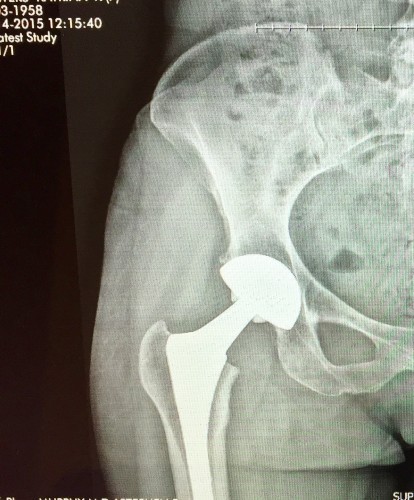 How you respond to that surprise is up to you.
How you respond to that surprise is up to you.
You probably already knew this would be the second lesson. It took me a while to learn it though. Looking back, I now see I went through something akin to the stages of grief as I absorbed the news that at age 57 –still youthful in my mind — I already needed replacement parts.
There was denial. Surely, if I juiced every morning and cut out sugar entirely and chewed turmeric and sipped ginger tea and took glucosamine and saw a chiropractor, and stretched a few times a day, I could avoid surgery. I did all those things. There were good days and bad days – that’s the way it is with arthritis– but the pain got worse.
There was anger. No, I didn’t have an incurable disease or even a frightening diagnosis. Even so, I indulged in my share of “why me?” moments. I watched a stream of college students running along the river in Cambridge one spring day, annoyed that they all clearly took their strong, straight legs and well-lubricated hip joints for granted. I waved to my adorable 80-year-old neighbor as she slowly jogged past my house, and silently cursed my own bad genes and bad luck. She was loping along, smiling, her white hair blowing in the breeze, and I was hobbling out to the mailbox. Yeah, I was pissed. (And perhaps this goes without saying — I was scared, too.)
Bargaining was irresistible. Ok, I would give up running for good, and tennis, too, if only I could hike. And then, fine, I could even let the hiking go, as long as I could manage a nice long walk. Or, even a short walk. I would modify my yoga practice, become more yin than yang, sit on two blocks, no on a chair, and I’d promise never, ever to even try to cross my legs again. Eventually, just walking up the stairs was hard. I gave up everything in the bargain, except the pain. (And although we don’t often admit this, pain is scary.)
I’m not the sort of person to sink into depression. But eventually depression and physical pain become inextricably intertwined. I think of all the days my husband and I would get up early for our morning walk, as we have always done, and how, after just a few minutes I’d have to turn back, admitting that the idea of a walk had become way more appealing than the actual experience. One by one, I lost all the physical outlets that have always relieved my stress and kept me strong and made me happy. Just getting in and out of the car was something of a project. Becoming increasingly sedentary I also became, almost imperceptibly, sad. “I feel as if I’m watching you get old before my eyes,” Steve said, more than once. That made me sad, too. (And it also made me scared – would I ever feel like me again?)
Acceptance, when it finally came, was a relief. A few days after the diagnosis, when I made an appointment with a surgeon in Boston, I was pretty sure I’d end up canceling it. Certainly in the eight long months between that initial phone call and his first available consultation, I’d cure myself! (See “denial.”) By the time I finally made my way to the surgeon’s office, all I wanted was two dates, one for the right hip and one for the left.
I had to wait five more months for the first surgery, and during that time my self-pity slowly gave way to gratitude that I had such good options. I couldn’t control everything, but I could control some things. And my own attitude was at the top of that list. Soon, I could shift gears at last, from coping to healing. I would begin the new year with two new hips. I hadn’t failed myself, I was taking care of myself. I was on a new path, toward renewed health and strength and mobility. I had family and friends ready and willing to support me. I could begin to make plans for the future. There was so much to be thankful for. It took a while, but I got there. (And perhaps this goes without saying – I was still scared.)
Ask for help. Then accept it.
This seems obvious. And yet as an able-bodied, nurturing, middle-aged mom I’ve been so much more comfortable being a caretaker than receiving care myself. I suspect I’m not alone in this. But people do want to help, and it’s our job to let them know how.
A year or so ago, on the evening before going into the hospital to have a kidney removed, a friend of mine sent out a group email, asking each recipient to pause the next day and send her healing vibes at the hour of her surgery. I felt so privileged to be on that list, glad both to be reminded of my friend’s surgery and honored that she wanted me to be part of her circle of support. Later, she said she felt all the love coming her way, that she rode that wave right into the operating room.
And so, the night before my first surgery, I followed her example. From Maine to California, good wishes poured into my email box. The next day, lying on the gurney in the pre-op room, watching the old-fashioned clock on the wall tick toward the appointed hour, I grew strangely, unexpectedly calm, even before the sedatives began to drip into the vein in my arm. The fear that had dogged me for weeks leading up to this moment melted away, replaced by something I can name only as peace. Was I held in an invisible web of care? Maybe so. Seven weeks later, the same thing happened again. Silent, stealthy, sacred: this is soul territory, the mysterious awakening of the energies of love.
Coming home from the hospital on Christmas eve, with little choice but to accept helplessness, I watched from my chair as a meal came together in the kitchen, one son making soup, the other assembling a salad with a friend, Steve pouring champagne and fixing my plate. Christmas cookies arrived at the door.
Saying yes to help was new to me. Having my husband help me into my underpants was new to me. Asking a friend to vacuum my kitchen floor was new to me. Accepting every offer of assistance that came my way was new to me. And yet, what lovely gifts these weeks have brought: delicious dinners, bags of groceries, fresh juice and homemade biscotti, a clean garage, rides to appointments, flowers and cards and books to read, an exercise bike for home, a hospital bed for daytime naps.
Saying yes to help is a way of saying yes to things as they are. Saying yes to help is about softening around the edges and loosening the boundaries. It’s about accepting that life is not to be controlled but surrendered to. And in that surrender, something new and beautiful begins to grow: the kind of openness and intimacy that deepens and fortifies a friendship, that burnishes a marriage, that acknowledges how very much we need each other.
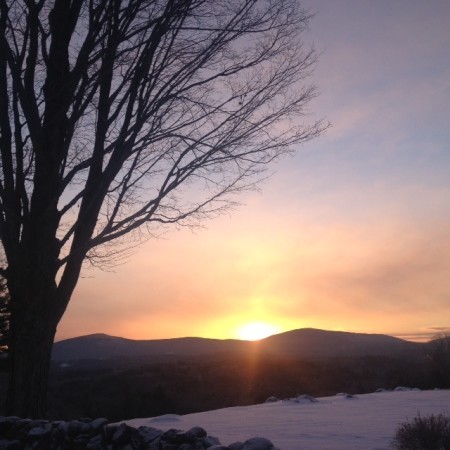 Some day your body will surprise you again.
Some day your body will surprise you again.
It happened sometime around three a.m., two nights ago. I was awake, content to be snug in my own bed, listening to the rise and fall of my husband’s breath. It was as cold as it’s been all winter, the sky crystalline, the bright crescent moon climbing higher, until it slipped into a dark tangle of branches in the maple tree outside the bedroom window. Stretching one leg out long and then the other, flexing my feet, I realized that for the first time in recent memory I felt no pain: no pain from arthritis, no pain from an incision, no pain from a new prosthesis, no pain from traumatized muscles. Nothing hurt.
Lying there in bed, at peace, relaxed and comfortable, I was acutely aware that something had shifted, deep beneath my awareness, from struggling to healing. This is me, I thought. Not perfect or intact, but not broken, either. It felt like a miracle.
While I have been diligently doing my exercises and taking my vitamins, drinking water and eating green veggies, resting and celebrating each small step of progress, my body has been doing its own invisible work. Day by day, I’m getting better. And for me that’s been the other big surprise: it turns out that even my wrinkled, saggy, puckery 57-year-old body is possessed of extraordinary regenerative powers.
And so, this paradox. So much of growing older is about learning to surrender, relaxing our attachment to what was and trusting that we are where we’re meant to be. At the same time, for as long as we’re alive, we dance in partnership with these mortal, resilient, remarkable, vulnerable bodies. And being a good partner means treating these bodies with loving care and respect, listening carefully to what they are telling us, and creating a calm, nurturing environment in which self-repair can continue to happen. We are all aging and healing at the same time. Growing a little every day and dying a little, too. This, it seems to me, is the holy wonder of the human journey, its beauty and its frailty. As Rilke writes, “Life always says Yes and No simultaneously.”
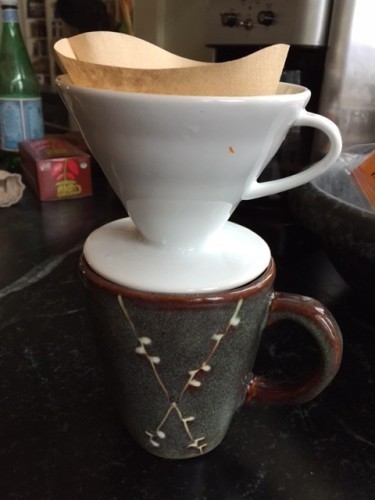 “I feel so lucky,” I said to my mom this morning. “I have all this time now that’s just for me.” It’s true. Although I knew I’d spend the month of January recovering from surgery, I didn’t ever expect these post-op weeks to feel like either a vacation or a gift, but it turns out they are both. I’m grateful for each quiet, solitary, elongated day. For expanses of time to nap and read and stretch and be. For nourishing food provided by dear friends, for texts that ping on my phone to say “I’m thinking of you.” I’m grateful for good books and dark chocolate and fresh coffee. Grateful to have no place to go and nothing much to do. (Except for PT appointments, my calendar is strangely, beautifully empty.) I’m grateful for a fire to sit beside and for my husband’s evening foot-rubs and for early bedtimes. For starry night skies and crystalline winter sunrises, for the cardinal at the bird feeder and for the pure rose light at dusk. I’m grateful for every step I take without pain. And I’m gratefully still learning all these lessons, it seems. Yes, always learning to be fully present.
“I feel so lucky,” I said to my mom this morning. “I have all this time now that’s just for me.” It’s true. Although I knew I’d spend the month of January recovering from surgery, I didn’t ever expect these post-op weeks to feel like either a vacation or a gift, but it turns out they are both. I’m grateful for each quiet, solitary, elongated day. For expanses of time to nap and read and stretch and be. For nourishing food provided by dear friends, for texts that ping on my phone to say “I’m thinking of you.” I’m grateful for good books and dark chocolate and fresh coffee. Grateful to have no place to go and nothing much to do. (Except for PT appointments, my calendar is strangely, beautifully empty.) I’m grateful for a fire to sit beside and for my husband’s evening foot-rubs and for early bedtimes. For starry night skies and crystalline winter sunrises, for the cardinal at the bird feeder and for the pure rose light at dusk. I’m grateful for every step I take without pain. And I’m gratefully still learning all these lessons, it seems. Yes, always learning to be fully present.
We look with uncertainty
We look with uncertainty
beyond the old choices for
clear-cut answers
to a softer, more permeable aliveness
which is every moment
at the brink of death;
for something new is being born in us
if we but let it.
We stand at a new doorway,
awaiting that which comes…
daring to be human creatures,
vulnerable to the beauty of existence.
~ Anne Hillman
The post four lessons I learned from surgery appeared first on Katrina Kenison.
December 11, 2015
best books for mindful parents— and a give-away
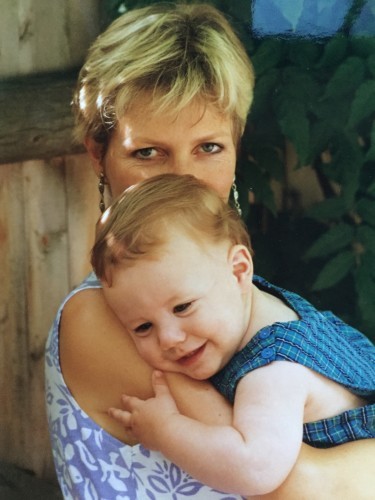 Twenty-five years ago, as a new mother trying to figure out what kind of mom I wanted to be, I went in search of books to guide me. I hoped to find some wise mothering mentors who could shine a light on the path at my feet and say, “Here, follow me, come this way.”
Twenty-five years ago, as a new mother trying to figure out what kind of mom I wanted to be, I went in search of books to guide me. I hoped to find some wise mothering mentors who could shine a light on the path at my feet and say, “Here, follow me, come this way.”
Looking back on those days now, I realize how much things have changed. Back then, there were no cell phones, the word “text” referred to print on a paper page, and news of the world arrived via the newspaper that landed on our doorstep each morning.
We bought our first computer in 1990, when Henry was three months old, so I could begin working from home at my new job editing The Best American Short Stories. My Apple IICX could run two programs at once, Clarisworks and Filemaker Pro, which meant I could do word-processing (an outdated phrase if every there was!) and keep a database of my two hundred-plus magazine subscriptions. I dialed in for an internet connection, kept all my reading notes on file cards, and corresponded with authors and friends through the mail.
There were no blogs to read or online parenting forums to join, there was no Amazon to browse nor any algorithm recommending books for me to buy, there was no Facebook. My husband took photos of our new baby boy with his 3-pound Nikon, we dropped the rolls of film off at CVS, and then carefully placed our 4 x 6 prints into a photo album, sending dupes off to the grandparents.
It all seems pretty quaint in retrospect, so innocent and simple. But at the time, working and raising children and trying to do it all and have it all and give it all to them, I still sensed that life was moving too fast. Much as I yearned for less pressure and more fun, my days were spent juggling: too much stuff, too many choices, too many obligations, never enough time.
We had a second son, and I kept on searching in the pages of books for a mothering soul mate, a friend with whom to share this challenging, rewarding journey.
I found plenty of expert advice on what my children should be doing at three months, six months, a year, and onward – there was no shortage of information about discipline, developmental milestones, feeding, crying, childhood illnesses, and separation anxiety. Although I renewed my subscription to Mothering magazine, the articles made me more uncertain, as if I’d already failed my children the moment I gave up on cloth diapers or bought baby food off the grocery store shelf rather than pureeing my own organic carrots. I found inspiration in Polly Berrien Berends’ timeless classic Whole Child/Whole Parent and some profoundly wise counter-cultural enlightenment in Joseph Chilton Pearce’s Magical Child.
But the calm, kind, older and wiser friend I was yearning for never did appear.
Finding my way forward, reading the works of Thomas Moore (especially Care of the Soul and The Re-Enchantment of Everyday Life), I began to grow as both a person and a mother. And I began to write my own version of the book I so wanted to read myself, with the idea that the living and writing would feed each other and that perhaps, deep down, I already knew more than I thought I did.
Last week, I opened an envelope containing a royalty payment for Mitten Strings for God: Reflections for Mothers in a Hurry. These modest checks have arrived steadily, twice a year, for fifteen years.
It is one of the great surprises and joys of my life that this small, personal book inspired so long ago by my own everyday life with my two young children continues to find its way in the world even now, speaking to parents in nine languages and to a whole new generation of families across the globe. My two sons are grown, 23 and nearly 26. But hardly a week goes by when I don’t hear from a mother somewhere who has read Mitten Strings and discovered a sense of kinship with my yearning, seeking younger self.
And over time, I’ve come to see that although the world is far more complicated than it was in 2000 when Mitten Strings was published, the ideas contained within its pages are timeless and universal. We can all use reminders to pause and pay attention to the invisible and the ineffable. We all need support when we choose to put quiet time or family time first. And it helps to know we aren’t alone in our longings for peace, intimate connection, and simple pleasures.
Fortunately for today’s families, there are now many wonderful books to support parents who wish to create soulful alternatives to lives that have become over-scheduled, over-stuffed, over-stressed, and over-shared.
I keep a small shelf full of the best of these titles. These thoughtful, courageous writers are the kinds of friends I longed for at the start of my mothering journey. But even now, as I find new ways to stay close to my adult children, I find much to ponder in these pages and lots of practical wisdom to help us all negotiate the day-to-day challenges of our media-saturated, attention-deprived, perfection-obsessed world.
And so to that end, I offer this short, idiosyncratic reading list of Best Books for Mindful Parents. Each of these books goes beyond the realm of childhood and parenthood; they speak to our human-being-hood. So, treat yourself to some new friends. Or, wrap up some Christmas shopping here. The parents (and the children) in your life will thank you.
by Kim John Payne
If you are raising children in these anxious times, you need this book. (How I wish it had been around when my own sons were little!) It will inspire you, reassure you, and, most important of all, it will remind you that less is more, that simplicity trumps complication, that rhythm and routine bring peace to the soul. In this profound and practical guide, Kim John Payne offers parents a doable, step-by-step approach to simplifying everyday family life, from the toy box to the dinner table. In the process, he reveals the rewards to be found in slowing down, savoring our children’s childhoods, and more fully enjoying our own adult lives. Kim Payne makes such a compelling case for simplifying, streamlining, and scaling back that I think of Simplicity Parenting as a kind of manifesto for the preservation of childhood. I give this book as a gift, more than any other, to all the young families I know.
It is never “too late” to bring inspiration and attention to the flow of family life Parents of young children will find many seeds here to plant toward a family life that continues to protect and nurture as children grow. But every stage in a family’s evolution can benefit from a little more space and grace, a little less speed and clutter.
by Galit Breen
For better and for worse, we live in a wired world. Galit Breen has written an indispensable manual of online manners for 21st century parents and their kids. With compassion, humor, insight, and practical wisdom born of some painful firsthand experiences, Galit makes a compelling case for kindness and decency. What would happen if every parent and child in American could read these ten simple rules, learn them by heart, and employ them every time they go online? The world would change dramatically – for the good of us all.
I have a theory that deep down inside, just like we’re all inherently good, we also already know what’s right. But sometimes this knowing gets muddled. Our online lives start with peeking at people from behind the safety net of an edited and filtered avatar, which can make it even harder to remember what we all know to be true: Kindness Wins.
Hands Free Mama & Hands Free Life
by Rachel Macy Stafford
Five years ago, special ed teacher and Type A, task-driven mom Rachel Macy Stafford had an ah-ha moment. Exhausted, frustrated, distracted and distraught, she decided she was done – done with racing through her own life and done with saying “Hurry up” to her “laid-back, carefree, stop-and-smell-the-roses” little girl. She started a blog to chronicle her daily struggles to be fully present and reweave her relationships with her husband and daughters. Pretty soon, Rachel was attracting a million online visitors a month. Her life-changing, hands-free journey resulted in a not-so-small parenting revolution and two best-selling books.
Hands Free Mama is “a guide to putting down the phone, burning the to-do list, and letting go of perfection to grasp what really matters.” Her newest book, Hands Free Life offers nine essential habits for “overcoming distraction, living better, and loving more.”
Rachel is the kind of mom friend we’d all like to have living next door, gentle and self-effacing, generous and wise. Well, we can’t invite her over for coffee but we can join her in the choice to let go of distraction and perfection to embrace what really matters. I think of both books as wake-up calls for anyone who wishes to parent more thoughtfully, love more generously, and live more meaningfully.
Today there might be mismatched socks. There might be not-so-healthy food choices. There might be messes, bulges, and fine lines where I don’t want them to be. But today I will be at peace with my less-than-perfect body and my less-than-perfect life. I refuse to waste precious time or hurt precious people (including myself) in my unachievable pursuit of perfection. After all, love doesn’t have to be perfect to be nurturing or nourishing.
by Lucy Jo Palladine, PhD
Are your kids glued to their screens? Are you?
This book has haunted me for months. It also woke me up, not only to the ways technology is rearranging the landscape of childhood, but also to the way it’s slowly but surely reshaped the contours of my own life. New technology finds its way into our homes even faster than we can begin to comprehend its effects on our families. In ways large and small, it’s changing the texture of our daily lives and the ways we relate to each other.
Lucy Jo Palladino doesn’t demonize technology – it’s here to stay and none of us really wants it otherwise. But she does give us the solutions we need to use it more thoughtfully. This practical, step-by-step guide is firmly grounded in science and the latest research, interspersed with compelling stories and firsthand experience.
You will learn a lot in these pages about how your own brain works and how your child’s brain is developing. And you will come away empowered, with the tools you need to help you regain control of your own technology use and teach your children – from toddlers to teens — how to understand and control their attention, and to realize when their attention is being “snatched.”
I cannot recommend this book highly enough. We owe it to ourselves and to our children to understand how the screens in our hands are altering our most intimate relationships, redirecting our attention, dictating our habits, and transforming our brains.
As we watch technology give rise to a new set of attention problems, we, as parents, need to do something that parents in past decades didn’t have to think about: we need to help our children learn how to resist the distraction their technology creates.
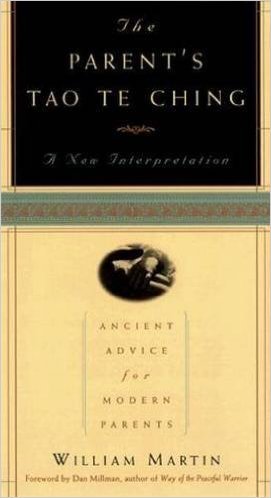 The Parents Tao te Ching: Ancient Advice for Modern Parents
The Parents Tao te Ching: Ancient Advice for Modern Parents
by William Martin
To my mind, no booklist for parents is complete if it doesn’t include this exquisite reminder of what really matters in our daily lives with our children: awe and wonder, gratitude and presence. William Martin’s loose, loving, freshly interpreted rendition of Lao Tzu’s Tao Te Ching distills the essence of that sacred text into accessible, heartfelt wisdom for parents. Here are 81 short chapters – each one only a page long — that seem to become deeper and more meaningful with each successive reading. It is a perfect gift for new parents, a helping hand to offer to parents who are struggling, and a lifelong guide to encourage each one of us remember that we can teach only by example and that as we devote ourselves to raising our children we are also, in fact, raising ourselves.
Live your own life
with all your heart,
with all your mind,
and with all your soul.
There is no need to live theirs.
They will do that wonderfully
by themselves.
holiday give-away
I have copies of each of Rachel Macy Stafford’s inspiring books, Hands Free Mama and Hands Free Life, to give away to one lucky reader, along with a signed copy of my own Mitten Strings for God. To enter to win all three books, just leave a comment below. Answer the question (one that’s on all our minds this season, yes?): How do you create moments of stillness in your daily life with your loved ones?
Feeling shy, or too frazzled to respond? You can simply say, “count me in.” I’ll choose a winner at random after entries close at midnight on Dec. 19. (US and Canada only.) Good luck!
Want to read these books now? Or tuck them into someone else’s Christmas stocking? You can order any of them by clicking on the hyper-linked titles above. (These are Amazon affiliate links.)
The post best books for mindful parents
— and a give-away appeared first on Katrina Kenison.
November 22, 2015
dear old(er): my best apple cake and the beauty of lying fallow
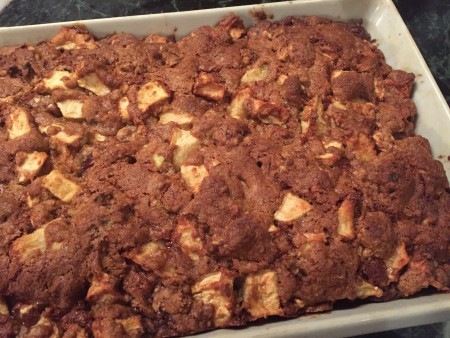
This is the fourth in a series of letters between me and my friend, author Margaret Roach, on the challenges (and joys!) of aging. I’m Old (just 56) and she’s Older (by 5 years). And since we’re surely not the only ones buying wrinkle creams, we decided to share our exchange with you, too. Be sure to read Margaret’s letter to me here. (Our earlier letters are here.)
Dear Margaret (my oldER friend),
There is something about these shorter days and longer, darker, colder nights. I’m wondering if you’re feeling it, too: the urge to hunker, to shut off the computer and read print on a page instead of a screen, to sip hot tea from a mug, to dress in layers of soft, comfy clothes, fashion be damned.
I’m turning lights on in my kitchen most days by three in the afternoon. And although I’m able now to drive my car, the truth is I’d rather be inside, cozied up on the loveseat with some pillows under my knees and my new favorite book in my lap. The impulse to stay put, safe and warm at home, is as strong as any pull to be out and about shopping for groceries or visiting friends.
This place I’m in now – mostly homebound, healing from one hip replacement and preparing my mind and body for another in a few short weeks – is definitely an in-between kind of territory, what a psychologist might call a “liminal space.”
I’ve always loved that word, liminal, so evocative and poetic. But I looked it up just now to make sure I’m using it correctly. Turns out, it derives from the Latin word limens, which means threshold – and it refers quite specifically to a discomfiting time of ambiguity, of not knowing, of disorientation.
So, yes! Liminal it is. And holing up at home here between surgeries, I do feel as if I’m being taken apart and put back together again, physically and spiritually. No wonder I feel so bare and vulnerable, so uncertain of the future and so hesitant to make any firm plans – even for next week. My body is busy with its cellular healing, but I seem to be doing some quiet, private, emotional work as well, absorbing the recent loss of my beloved friend, of my own worn-out body parts, and even of my old way of being in the world.
Before you can begin something new, you have to end what used to be. Before you can become a different kind of person, you must let go of the old identity. Before you can learn a new way of doing things, you have to unlearn the old way. ~ William Bridges
The active, busy, middle-aged life I took for granted just a short time ago is over. No more long runs at dawn. No more scampering up and down the stairs countless times a day. No more teaching yoga, bending over to pick things up off the floor, sitting cross-legged on my meditation cushion, or hurrying across a busy intersection. No more getting in and out of a car without a thought as to how my legs are bending.
I may do these things again in the future. But my new post-op life has yet to begin. Right now, I’m wearing white knee-high compression stockings and having my blood drawn every few days and taking very slow, very short walks as far as the next door neighbor’s house.
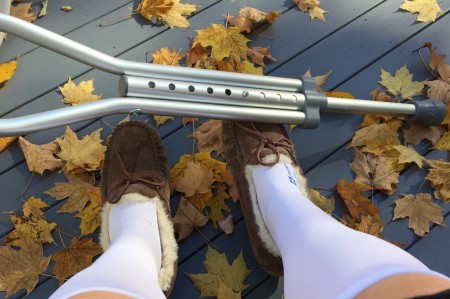 Although I do daydream a bit, trying to envision what it’ll be like to be pain-free and mobile once again, there remain some rather daunting challenges between my current perch on the couch and where I hope to end up six months from now: hiking and vacuuming and bike riding and forward bending.
Although I do daydream a bit, trying to envision what it’ll be like to be pain-free and mobile once again, there remain some rather daunting challenges between my current perch on the couch and where I hope to end up six months from now: hiking and vacuuming and bike riding and forward bending.
In the meantime, here I am. On pause. Living in my body as a question rather than as a statement. Waiting and wondering what may be possible and where my new sense of purpose will come from. And asking that unsettling, age-old question that always bubbles up when I’m not really sure what I’m supposed to be doing: Now what?
As usual, I turn to wise writers in search of answers. A quick inquiry into liminal spaces yields this from theologian Richard Rohr, who reassures me that no one enjoys these awkward times of waiting and not knowing – but that they are always essential to growth.
It is when you have left the tried and true, but have not yet been able to replace it with anything else. It is when you are finally out of the way. It is when you are between your old comfort zone and any possible new answer. If you are not trained in how to hold anxiety, how to live with ambiguity, how to entrust and wait, you will run away. . . (you’ll do) anything to escape this terrible cloud of not knowing. ~Richard Rohr
Hmmm. Okay. I get it. In fact, I felt the same way when I left my publishing career for motherhood, and again when my two sons left home and I suddenly found myself out of a job, wondering if I’d ever feel needed or useful or fully engaged in life again. The “fertile void” of the newly empty nest was dark and uncomfortable but in time I found my way through it – or rather, I wrote my way through it and gave birth to a book.
Actually, I’m relieved to be reminded that this “cloud of not knowing” is an inevitable part of transformation – even if the only transformation I can see right now is my own self growing older. And it helps to be reminded that the way to rise to this challenge is to soften into it. To be still and listen carefully, to be a bit more open to what the universe seems to be handing me at this moment. Yet another gentle nudge, perhaps, to stop trying so hard to do more, and to “let be” instead?
It’s not so much that we’re afraid of change or so in love with the old ways, but it’s that place in between that we fear…it’s like being between trapezes. It’s Linus when his blanket is in the dryer. There’s nothing to hold on to. ~ Andre Gide
I’m thinking of you too here, my friend. Seems to me we are both guilty of filling our days with lots of “to-dos,” only to wonder as the sun goes down what in fact we’ve actually done. We both tend to be hard on ourselves – whether its because new projects aren’t falling neatly into place or because our bellies and our chins aren’t as firm as they once were or because we seem to need nine hours of sleep these days instead of seven.
Well, maybe it’s time for both of us to embrace this in-between territory. Neither of us can call ourselves middle-aged, but we can’t claim crone status, either. We’re each really good at filling our days with busyness, but we aren’t quite sure of our own next steps. We aren’t who we used to be a few short years ago when we first met (each of us shepherding new memoirs into the world), but we’re not quite clear on who we’re becoming or what we’re meant to be doing next.
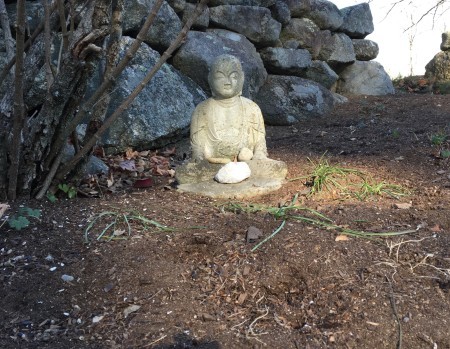 So maybe we take our cues from nature. There is a difficult discipline to finding ease and beauty in these stark days of November. Autumn is over, but winter has yet to begin. The outdoor chores are finished (I did not get the last of my own bulbs in the ground, but so be it), yet we are still a ways off from snow boots and driveways to shovel. See the parallels? In my own garden, one tiny black-eyed Susan, poking up between the paving stones, seems determined to defy the season. But otherwise, the beds are barren, silent, still. And yet, as gardeners we both know there’s all sorts of work going on beneath the surface. Lying fallow is different from doing nothing.
So maybe we take our cues from nature. There is a difficult discipline to finding ease and beauty in these stark days of November. Autumn is over, but winter has yet to begin. The outdoor chores are finished (I did not get the last of my own bulbs in the ground, but so be it), yet we are still a ways off from snow boots and driveways to shovel. See the parallels? In my own garden, one tiny black-eyed Susan, poking up between the paving stones, seems determined to defy the season. But otherwise, the beds are barren, silent, still. And yet, as gardeners we both know there’s all sorts of work going on beneath the surface. Lying fallow is different from doing nothing.
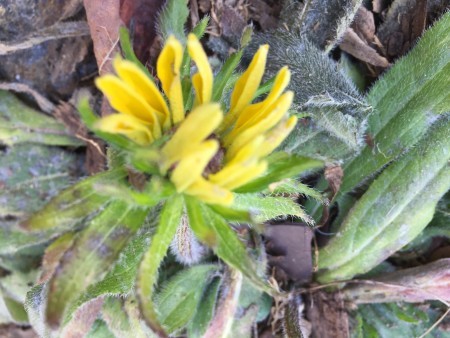 To lie fallow is a gift. But we don’t really know how to do it. November, it seems to me, is a perfect time to practice a kind of contemplative intimacy with the unknown. Acceptance, yes. Surrender, even? Yes, although surrender isn’t the same as just hiding under the bedclothes and giving in.
To lie fallow is a gift. But we don’t really know how to do it. November, it seems to me, is a perfect time to practice a kind of contemplative intimacy with the unknown. Acceptance, yes. Surrender, even? Yes, although surrender isn’t the same as just hiding under the bedclothes and giving in.
Lying fallow is not about stagnating, it’s about making a friend of silence, being where we are, feeling everything, and beginning to listen more carefully to the voice of the heart. It’s about trusting that the old story is already being transformed into a new story, and that growth and healing and regeneration will always happen if we’re patient. Perhaps that quality of humble, willing “here-ness” is what we can cultivate together.
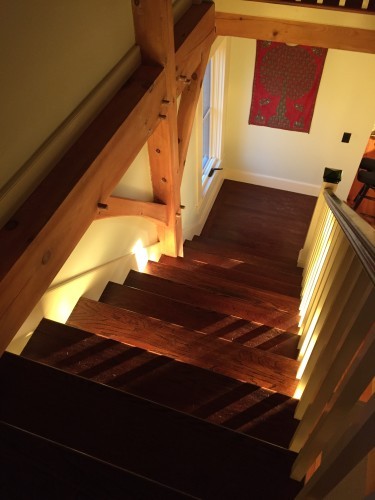 With that in mind, here’s a glimpse of my day. Making my way slowly down the hallway in the early morning, I stop to notice the light. I marvel at a glowing door, at golden shadows dancing before me on the stairs. Stepping outside to watch the birds at the feeder, I feel the cold morning air on my skin and greet the place we live. My husband, doing most of my chores these days, puts dishes away, tidies the kitchen after breakfast, helps me with my shoes and socks. Once he’s gone to work, the empty hours stretch before me. I answer email and write some checks, a thank you card, a note. I peel apples, grate nutmeg into a bowl of flour, stir batter and, slide a cake into the oven. The sun pours in and the kitchen fills with good smells. I stand on my yoga mat and do some half sun-salutations, bending only partway over, breathing deeply, a beginner again as I learn to work with this new, untested version of my body. I write for a while and water the plants and talk with a friend who stops by to say hello. At dusk I lie on the couch, legs elevated, and reach for Mary Oliver’s luminous new book of love poems, Felicity, allowing her words to land in my heart.
With that in mind, here’s a glimpse of my day. Making my way slowly down the hallway in the early morning, I stop to notice the light. I marvel at a glowing door, at golden shadows dancing before me on the stairs. Stepping outside to watch the birds at the feeder, I feel the cold morning air on my skin and greet the place we live. My husband, doing most of my chores these days, puts dishes away, tidies the kitchen after breakfast, helps me with my shoes and socks. Once he’s gone to work, the empty hours stretch before me. I answer email and write some checks, a thank you card, a note. I peel apples, grate nutmeg into a bowl of flour, stir batter and, slide a cake into the oven. The sun pours in and the kitchen fills with good smells. I stand on my yoga mat and do some half sun-salutations, bending only partway over, breathing deeply, a beginner again as I learn to work with this new, untested version of my body. I write for a while and water the plants and talk with a friend who stops by to say hello. At dusk I lie on the couch, legs elevated, and reach for Mary Oliver’s luminous new book of love poems, Felicity, allowing her words to land in my heart.
No, I’d never been to this country
before. No, I didn’t know where the roads
would lead me. No, I didn’t intend to
turn back.
And it hits me: when I offer myself this kind of faith in myself, the berating, questioning voice becomes a more compassionate one. When I give myself permission to be with what is, each moment becomes precious. Any fruitfulness – whether it be this letter to you or a cake cooling on the counter – arises from this surrendered openness. It is a rare joy to allow a day to have its way with me. So here’s to liminal time and to not knowing and to this brief season of lying fallow. We can find life right here, rich and fertile, hidden between chapters. (And we can eat well, too!)
xoxo
your slow-moving friend
the only apple cake recipe you’ll ever need
I found this cake on the wonderful (and highly addictive Food52 site) and have tweaked it a bit over the course of many bakings. Here’s my version:
3/4 cups chopped dates
1/2 to 3/4 cups apple brandy (actually any brandy will do)
2 cups unbleached, all purpose flour
1 1/2 cups sugar (I use half white and half brown sugar)
2 teaspoons baking soda
2 teaspoons ground cinnamon
1 teaspoon ground nutmeg
1 teaspoon cardamom
3/4 teaspoon salt
4 cups slightly tart apples: peeled, cored and roughly chopped
1 cup roughly chopped walnuts or pecans
1/2 cup melted sweet butter
2 eggs, lightly beaten
confectioners sugar for sprinkling on top
About one hour before starting to bake, place the dates in a small bowl and cover with the brandy. Stir from time to time and if they get too “tight,” just add more brandy!
Preheat oven to 325. Using butter, grease a baking pan (approximately 13 x 9 x 2)
Into a large bowl sift together flour, sugar, baking soda, cinnamon, cardamom, nutmeg and salt.
Add the chopped apples, dates, nuts, melted butter and the eggs. This will be a very heavy, thick batter but don’t worry — just be sure to mix it well.
Spread in the prepared pan, place on a rack in center of the oven and bake for 1 hour. Test with a skewer — if it comes out still a bit gooey, bake for another 5 to 10 minutes. You’ll know when it’s done. It will be a nice dark tan color and will spring back to a light touch.
Remove from oven, let cool a bit. This is delicious hot, warm or cold, for breakfast, lunch, or dinner. It’s as good served with a slice of sharp cheddar as it is with a scoop of vanilla ice cream. It’s a humble looking cake; if you want to dress it up for guests, sprinkle each serving with a dusting of confectioners sugar.
The post dear old(er):
my best apple cake
and the beauty of lying fallow appeared first on Katrina Kenison.
November 6, 2015
oasis
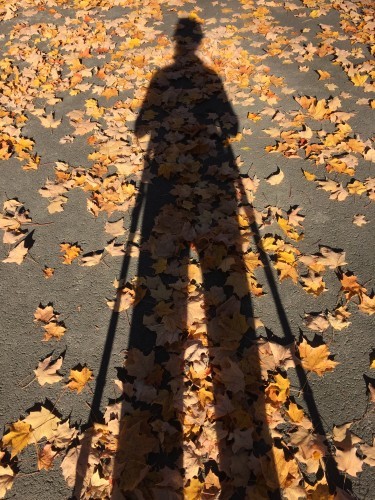 The surgeon was running a little late. I was right on time. I had followed every pre-op instruction to the letter: donated a unit of my own blood to receive back during surgery, had an MRI and new X-rays, taken my liquid iron and B vitamins and blood thinner and Celebrex, met with an anesthesiologist, a physical therapist, a pharmacist. I’d given up coffee and my evening glass of wine days ago, had my teeth cleaned (from now on, that will involve a precautionary dose of antibiotics), tidied up the house and paid the bills, and scrubbed my right hip twice a day for three days with Hibiclense. I even got my hair cut.
The surgeon was running a little late. I was right on time. I had followed every pre-op instruction to the letter: donated a unit of my own blood to receive back during surgery, had an MRI and new X-rays, taken my liquid iron and B vitamins and blood thinner and Celebrex, met with an anesthesiologist, a physical therapist, a pharmacist. I’d given up coffee and my evening glass of wine days ago, had my teeth cleaned (from now on, that will involve a precautionary dose of antibiotics), tidied up the house and paid the bills, and scrubbed my right hip twice a day for three days with Hibiclense. I even got my hair cut.
Through it all, I worried and wondered. Was I doing the right thing? Would I be better off to accept my lot, buck up, and carry on with my own two painfully arthritic hips? Was I trying too hard to hold on to youth? Being greedy to want to hike or do triangle pose or ride a bike again? Or would I look back, as a few hip-replacement veterans predicted, and wonder why I waited so long to get new parts?
By the time I climbed into my assigned bed in a small pre-op cubicle at New England Baptist Hospital last Friday, there was nothing more for me to do. And there was certainly no point to any more mental dithering and debating. A curious, unexpected calm descended.
I was warm and comfortable. Whatever happened next was completely out of my hands. I’d expected to find myself at this juncture feeling terrified, with clammy hands and a heart pounding with anxiety — my typical response to stress. Instead I was . . . peaceful. It occurred to me that this is what faith feels like – the quiet, still, rather unfamiliar place Khalil Gibran calls “an oasis in the heart which will never be reached by the caravan of thinking.”
Somehow, moments away from the first major surgery of my life, I had found my way to that oasis. An accidental destination, deep and mysterious and welcome.
“We’ll give you something to make you relax before we take you in to the operating room,” a nurse promised as she deftly slipped an IV needle into a vein in my wrist. As it turned out, there wasn’t time to administer the drug meant to soothe my nerves. When the doctor was finally ready, he wanted me in there on the table, pronto. It didn’t matter. Some invisible current had already begun to flow. And I had given myself over to it.
As I sit on the screened porch at my parents’ house six days later typing these words, there are many small details of the last month that come bubbling up. Since I last wrote in this space, my beloved friend Lisa died after a long journey with brain cancer. The intensity of her final weeks and the intimacy, wonder, and grace of the three-day vigil friends and loved ones created after her passing — sitting with her body, reading and singing and praying and speaking to accompany her soul as it departed – every bit of this is all still vivid in my mind. (A subject for another day perhaps.)
The grief I feel is fresh, but not raw. There is a quiet oasis in my heart for this sadness, too. I keep thinking of the dream I had in the recovery room on Friday, exactly two weeks after Lisa’s death. While swimming my way back to consciousness after surgery, I experienced something that was perhaps more illumination, or visitation, than dream: Lisa and I sitting together having a picnic by a lake, a shared sense that all was well, that there was nothing very unusual here, just our simple joy in seeing each other.
Moments later – or maybe an hour later? who knows? — I woke up from that shimmering picnic, surrounded by nurses speaking my name. The first days with my new hip were more than I’d bargained for: the pain, the nausea, the foggy brain, the plugged up digestive system, the pully hanging over the bed for slowly moving my leg, the hesitant steps on crutches, the mushy, marshy nowhereland between sleep and wakefulness, neither of which was fully achievable.
And yet. Somewhat to my surprise, I was still in the oasis, still at peace, still surrounded by kindness and love. Held afloat by the good wishes and prayers of a whole circle of dear friends, I had only one task: to relax into that love and allow it to bear me forward.
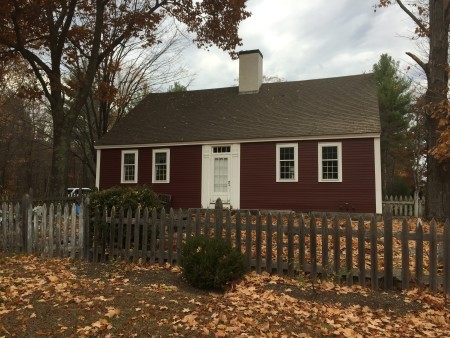 On Sunday afternoon, my husband drove us here, to my parents’ house, the finest rehab facility anyone could wish for. My mother ceded to us their king-sized bed and bathroom on the first floor and greeted me with turkey soup, tulips, and the ice pack of my dreams. And so, just months before my parents leave this dear old house forever and move into the new smaller one they’re building closer to us, I find myself returned to the home of my childhood for one last time.
On Sunday afternoon, my husband drove us here, to my parents’ house, the finest rehab facility anyone could wish for. My mother ceded to us their king-sized bed and bathroom on the first floor and greeted me with turkey soup, tulips, and the ice pack of my dreams. And so, just months before my parents leave this dear old house forever and move into the new smaller one they’re building closer to us, I find myself returned to the home of my childhood for one last time.
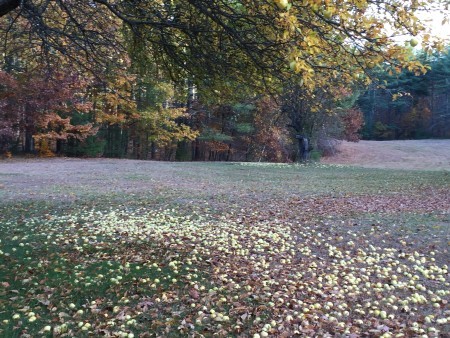 The autumn leaves drift down, a golden dance of deliverance. In the backyard, the apple tree – so much broader now than when we two first met nearly 45 years ago – has released her generous crop of golden apples, spread around her like a skirt. As I make my way slowly around the back yard on my crutches, I must be mindful of fallen acorns thick underfoot, the oak trees’ abundant yield. Every where I look, it seems, something is letting go.
The autumn leaves drift down, a golden dance of deliverance. In the backyard, the apple tree – so much broader now than when we two first met nearly 45 years ago – has released her generous crop of golden apples, spread around her like a skirt. As I make my way slowly around the back yard on my crutches, I must be mindful of fallen acorns thick underfoot, the oak trees’ abundant yield. Every where I look, it seems, something is letting go.
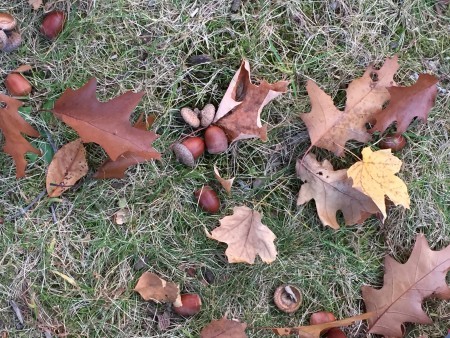 Even as my parents await their moving day, the new owners of this land have begun to realize their own vision for it, carving out roads and house lots and felling trees. Each day, we listen as the forest my brother and I wandered as children disappears. Early this morning the huge machine was right at the edge of the yard. For my mother, who has spent most of her adult life in silent conversation with these trees, it was wrenching to see them shudder and fall, one after another, each loss forever changing the landscape of this place we all still think of as home. Little wonder that we found ourselves in tears.
Even as my parents await their moving day, the new owners of this land have begun to realize their own vision for it, carving out roads and house lots and felling trees. Each day, we listen as the forest my brother and I wandered as children disappears. Early this morning the huge machine was right at the edge of the yard. For my mother, who has spent most of her adult life in silent conversation with these trees, it was wrenching to see them shudder and fall, one after another, each loss forever changing the landscape of this place we all still think of as home. Little wonder that we found ourselves in tears.
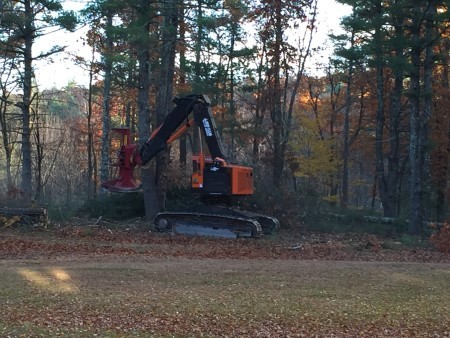 “You knew this was going to happen,” my dad reminded her. And of course we did. Still, for a few moments there, as I stood on my crutches and my mother leaned on her cane in the unseasonably mild sunshine, and the trees crashed down one by one, the symbolism was almost too much to bear – the last act of The Cherry Orchard revisited.
“You knew this was going to happen,” my dad reminded her. And of course we did. Still, for a few moments there, as I stood on my crutches and my mother leaned on her cane in the unseasonably mild sunshine, and the trees crashed down one by one, the symbolism was almost too much to bear – the last act of The Cherry Orchard revisited.
But in a little while the workers moved on, out of sight. The felled trees were silent, the view out past the field so much vaster than before.
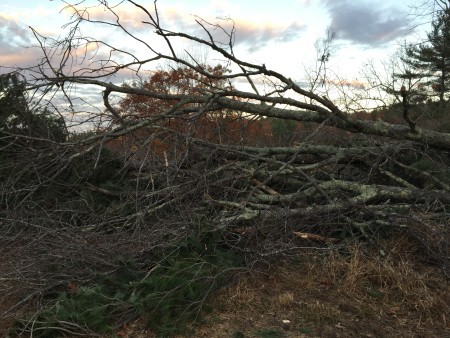 My parents spent many years creating a home here, but they leave it behind knowing full well the time has come to let go. In a sense, the letting go happened already, as they chose a new place to live, sold this one, began cleaning out sheds and cellars and drawers. For them, too, the debating and deliberating is over, and there is nothing to do but have faith in their own next steps.
My parents spent many years creating a home here, but they leave it behind knowing full well the time has come to let go. In a sense, the letting go happened already, as they chose a new place to live, sold this one, began cleaning out sheds and cellars and drawers. For them, too, the debating and deliberating is over, and there is nothing to do but have faith in their own next steps.
A few days before my surgery, I admitted to my husband that I wanted a break from lessons in letting go. The last year has been hard, one loss after another. And the two hip replacements, though my own choice and surgeries from which I expect to fully recover, well, they represent a kind of loss as well.
It’s been a long time since I went up the stairs without grimacing or walked without pain. The two-year-long medical journey that led me to this decision has been humbling in every way. And, too, there is a vulnerability after surgery that’s altogether new to me, as challenging in its own way as any of the physical trauma. Like most of us, I much prefer the role of capable care-giver to that of needy patient. But here I am. My husband spots me as I step gingerly into the shower. My mom wrestles my tight support stockings up over my calves. My friends, bless them all, are offering meals. A nurse comes every couple of days to check my INR levels. I look at the pharmacy’s worth of medications and vitamins on the counter and can hardly believe they belong to me, the girl who eschews Tylenol.
And so, moment by moment and day by day, even as I heal and graduate to one crutch and learn to use the four-foot-long shoe horn to get my sneakers onto my feet, I also have to surrender over and over again to this new vulnerability, and to the loss of my young, fit, able body that served me so well for so many years with all its own parts intact. Right now, my newly operated on right leg is one inch longer than the left. The next surgery, no longer optional, will even me out. Till then, I’ll wear different kinds of shoes on each foot. No matter; I’ve had to let go of my fashion aspirations, too.
But just now, as I finally have the time and space to sit quietly and begin to reflect on all that’s happened in my life this autumn, I’m beginning to see things a little differently. Perhaps the hard lessons I’ve been learning haven’t been so much about letting go as they have been about letting be. “Letting go” suggests a need to actively do something: let go of hurt, let go of fear, let go of what’s over, let go of expectations of what will be next.
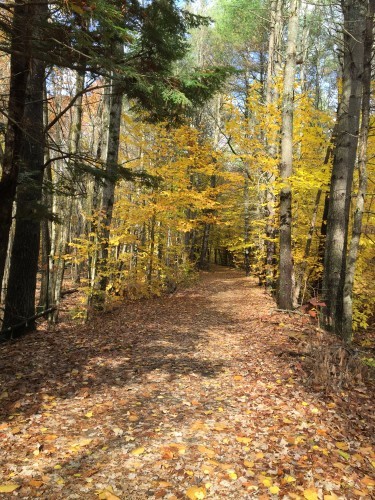 What if there is a path to the oasis in the heart after all? And what if that path opens at our feet when we stop trying so hard to decipher the roadmap through life and allow ourselves instead to simply be with life as it is?
What if there is a path to the oasis in the heart after all? And what if that path opens at our feet when we stop trying so hard to decipher the roadmap through life and allow ourselves instead to simply be with life as it is?
Everything comes and goes: the green of springtime and the fleeting gold of fall, the apple blossoms of May and the ripe fruits of October, the tiny acorn and the mighty oak. Not to mention youth and age, homes and bodies, hopes and dreams, life and death. We don’t have to do anything – neither hold on tight nor let go. We can just let it be.
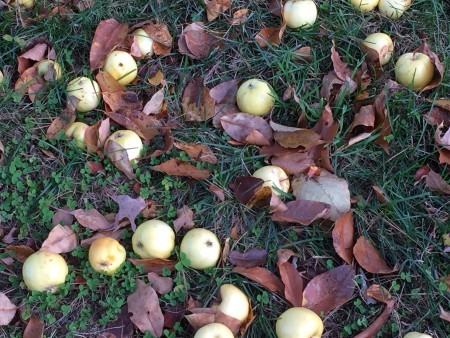 “People who have faith in life are like swimmers who entrust themselves to a rushing rivers,” says the wise Benedictine monk David Stendhal-Rast. “They neither abandon themselves to its current nor try to resist it. Rather they adjust their every movement to the watercourse, use it with purpose and skill, and try to enjoy the adventure.”
“People who have faith in life are like swimmers who entrust themselves to a rushing rivers,” says the wise Benedictine monk David Stendhal-Rast. “They neither abandon themselves to its current nor try to resist it. Rather they adjust their every movement to the watercourse, use it with purpose and skill, and try to enjoy the adventure.”
Enjoy the adventure. I love this idea just as much as I love the image of an oasis in my heart. And it seems that “letting it be” is both a profound affirmation of faith and an opening to possibility. I am savoring this quiet, healing time more than I ever would have expected. After many, many months of doing, being is quite a welcome relief. After all that worrying and second-guessing, it is lovely to allow my own caravan of thinking to come to a halt for a while. After a long chapter of caregiving, offered with all my love, I’m deeply grateful to those who are showing up to care for me. I do my new hip exercises. I read and take naps. Slow walks up and down the driveway. Some chair yoga. The oasis in my heart is green and quiet, its waters undisturbed. The days fly by.
a bit more. . .
So many of you reached out with kind words during my friend’s illness and that circle of support meant a great deal. It was an honor for me to have an opportunity to write Lisa’s obituary, to spend a few days trying to capture the essence of this very special friend and teacher. For those who might wish to know more about her, here’s a link that will bring you to the full version of my remembrance of her. May you, too, be inspired by the qualities she embodied. Click here.
On September 27, I joined Team Diane for the last seven miles of the Jimmy Fund Marathon Walk. Buoyed on by ibuprofen, my commitment to this important cause, and my dear friends (and glad that by mile 19, their pace had slowed down a good bit), I was able to walk that day in support of ovarian cancer research. And thanks to YOUR incredibly generous contributions, my walk brought over $2,500 directly to Dr. Ursula Matulonis and her ovarian cancer research team at Dana Farber. My very belated individual notes are coming soon. But in the meantime, here, now: thank you!
The post oasis appeared first on Katrina Kenison.
September 11, 2015
beautiful things
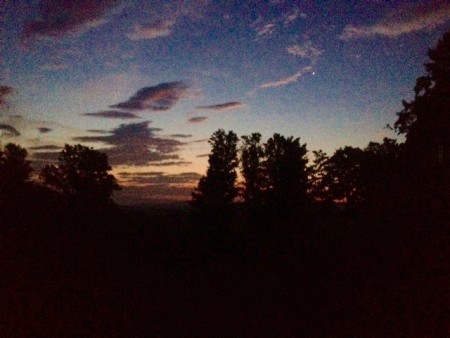 This quiet morning. My friend asleep in her bed, snuggled deep in a nest of pillows, her faithful terrier molded to the curve of her back. The gentle rise and fall of the covers, her breath coming slow and steady when I peek in to check on her.
This quiet morning. My friend asleep in her bed, snuggled deep in a nest of pillows, her faithful terrier molded to the curve of her back. The gentle rise and fall of the covers, her breath coming slow and steady when I peek in to check on her.
Six a.m. My shift. The house is still but for the steady tick of the kitchen clock, empty but for the two of us. What twists and turns of fate have brought us to this moment? One woman engaged in the deep inner work of letting go of life. And the other, me, still here, striving to see this world as perfect, to love it as it is.
I pour coffee, slice a peach, and carry my breakfast to the back deck where the two of us have spent so many companionable, peaceful hours over the last year. The dark trees are still silhouetted against the sky. Clouds at the horizon deepen to shades of rose. The sky lightens. In the new light, dragonflies stitch invisible seams through the morning. A blue heron wings by, heading from one secret pond to another.
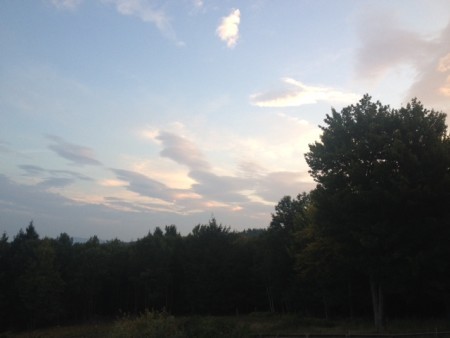 My notebook is open before me, the lovely white page. I tip my full heart over and pour myself out. A list takes shape: all the hard, sad things. It doesn’t take me long to write them down. Just putting words to my feelings brings a certain unexpected relief, like setting down a bag full of rocks. Tears come. And this, too, is a relief.
My notebook is open before me, the lovely white page. I tip my full heart over and pour myself out. A list takes shape: all the hard, sad things. It doesn’t take me long to write them down. Just putting words to my feelings brings a certain unexpected relief, like setting down a bag full of rocks. Tears come. And this, too, is a relief.
And then, as I read through my list, one thing is suddenly, startlingly clear. Most of the things on it are out of my control : my friend’s progressive, inevitable decline; the behavior of others; the chronic pain in my hips and lower back; the plight of Syrian refugees; the end of summer; a friend’s inexplicable silence; a lie I’ve been told and asked to believe; deepening wrinkles and upcoming surgeries and canceled plans.
For a while now I’ve been stuck in this place — waiting, fragile, sad, hurting. Feeling as if my life is on hold until I’m no longer needed as a caregiver, or until I can walk and bend over without pain, or until a difficult relationship is resolved.
I’m wrong, of course.
I’m not waiting. I’m living.
And this moment is neither “good” nor “bad,” but simply life as it is, complex and messy and precious and beautiful: the immense mystery of a loved one’s slow dying, my own body growing older, the first leaves changing color, a cherished friend turning away, a new one reaching out a hand, a ripe peach for breakfast, a blue heron in flight, another day dawning.
On the wooden table where I sit, there is a tiny pile of stones. I pick them up and spread them out. Hearts.
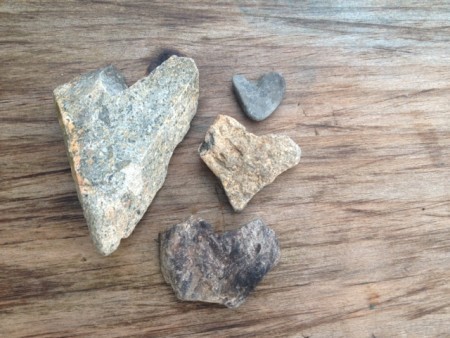 And with that, I begin another list. Beautiful things. I need only look up to see them.
And with that, I begin another list. Beautiful things. I need only look up to see them.
And I need only awaken to the vast, varied territory of my life in this moment to feel grateful for all I have, for all that is. I easily fill a page and then another, there is no end to these riches. Soon my heart feels full once again, but in a different way now. No longer heavy, but spacious. Buoyant, even.
Perhaps this is the invisible gift offered us if we are blessed to accompany another through the final days of their journey: an invitation to go deep and to feel everything. For surely we can trust that life will offer us great joy and great sorrow, and that we are here to know both intimately, even as we grow ever more attuned to the small, daily, simple things like breathing and walking and whispering and hugging.
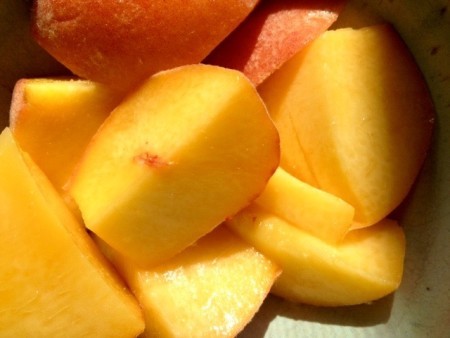 Paying attention changes everything. Gratitude multiplies and transforms a day, a life, the world. Choosing to see beauty creates more beauty. Nothing is on hold. Nothing lasts. Nothing is wasted. And so, this really is it: the mystery, the miracle, the pain, the joy, the whole human catastrophe. And we get to be here, now.
Paying attention changes everything. Gratitude multiplies and transforms a day, a life, the world. Choosing to see beauty creates more beauty. Nothing is on hold. Nothing lasts. Nothing is wasted. And so, this really is it: the mystery, the miracle, the pain, the joy, the whole human catastrophe. And we get to be here, now.
That, surely, is a beautiful thing.
And so, I find myself with this new daily practice, a slight variation on the gratitude journal I’ve kept on and off for years. I wonder what will happen if I continue to begin every day by noticing and writing down a short list of beautiful things? And I wonder what’s on your list of beautiful things, right this minute? I’d love to know.
All that matters is what you love
and what you love is who you are
and who you are is where you are
and where you are is where you will be
when death takes you across the river.
You can’t avoid the journey but
you can wake up… now
and see where you’ve been
and where you are going.
– John Squadra, from “Circle Of The One,” in This Ecstasy
(With thanks to Rod MacIver for sharing this poem on A Pause for Beauty.)
The post beautiful things appeared first on Katrina Kenison.
August 30, 2015
a friend remembered, a legacy (and a video to watch)
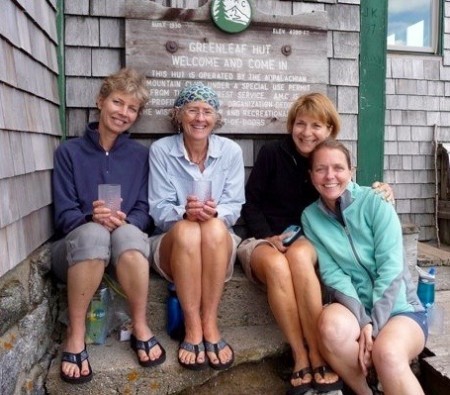 I love this photo. Four friends who have just changed out of heavy boots and into flip flops at the end of a long day of hiking. We would sleep fitfully in our bunk beds that night in Greenleaf Hut, high in the White Mountains, under scratchy woolen blankets. We would smush soft pink plugs into our ears to drown out the roof-rattling snores from the mens’ dorm. And in the morning we would laugh our way down the mountain in the rain.
I love this photo. Four friends who have just changed out of heavy boots and into flip flops at the end of a long day of hiking. We would sleep fitfully in our bunk beds that night in Greenleaf Hut, high in the White Mountains, under scratchy woolen blankets. We would smush soft pink plugs into our ears to drown out the roof-rattling snores from the mens’ dorm. And in the morning we would laugh our way down the mountain in the rain.
We would not talk about cancer or clinical trials or miracles. We would not mention what we all knew to be true: that this would be the last time we’d ever climb a mountain together. For twenty-four hours, we simply savored the moments at hand: the glorious views from the top, the soggy sandwiches in our backpacks, the slick trail under foot, silly jokes, wet socks, togetherness.
Just over a year later, in October 2010, my dear friend Diane died of ovarian cancer. (That’s her in the black fleece, looking radiant despite the fact she’d spent the early morning in the hospital getting an experimental treatment.)
As I type these words, I carry another close friend in my heart as she nears the end of her own journey with cancer. And I am reminded, with equal parts of gratitude and sadness, of the lessons Diane taught me during her illness.
Loss attunes us to what is meaningful. And although a cure may not be possible, healing always is. Diane never once asked, “Why me?” Instead, she said, “Why not me? It could have been any one of us who got sick.”
And with that, Diane made two decisions: to respond to her disease with aggressive treatment and to fully embrace the simple pleasures of her everyday life. Under the cutting-edge care of the Dana Farber Cancer Institute, she was able to do both for nearly four years.
Diane couldn’t change the outcome of her disease. But her commitment to hope and healing never wavered. From the time she was first diagnosed until the final weeks of her life, she worked tirelessly to support ovarian cancer research.
Each year, over 25,000 women are diagnosed with ovarian cancer. It was Diane’s wish that earlier detection and more effective treatments would improve the odds for every other woman who might follow in her footsteps.
Her courage and commitment are my inspiration.
Later this fall, I will be having two consecutive hip replacements. My own walks these days are short. My steps are small. My pace is slow. But I’m determined to keep moving. And on September 27, I will once again lace up my sneakers and join Team Diane for the Boston Marathon Jimmy Fund Walk. Although I can’t commit to the full 26. 2 miles this year, I’ll do what I can. I’m more aware than ever that this cause is so much bigger than any one of us.
Walking together over the last four years, our small group has raised over $150,000 – money that goes directly to Diane’s oncologist, Dr. Ursula Matulonis, and her cutting-edge research team at Dana Farber.
Over the summer, I worked with a dear young friend (and iMovie whiz) on a video to tell the story of our group – of a death that arrived too soon and of the extraordinary goodness that can arise from grief.
I hope you’ll take a few minutes to watch. (For full screen on YouTube: click here.)
Meet my friend and catch a glimpse of her indomitable spirit. See the powerful legacy she left behind. Share the link with your friends. And join with Team Diane to carry this urgently needed work forward.
In the words of Alice Walker, “Activism is the rent I pay for living on the planet.” As many of you know, this cause is close to my heart. And once a year I am honored to share it with you here. I’m humbled, always, by your generosity. Thank you for donating — in any amount — to this effort that means so much to me and to so many others. I am deeply grateful for your support.
To learn more and to donate to my walk, click here.
Blessings and thanks, from my full heart to yours,
Katrina
p.s. Want to send a check? Easy: make it out to Jimmy Fund Marathon Walk. In the memo line, write “Diane’s Fund.” Mail it to me: Katrina Kenison, 101 Middle Hancock Rd, Peterborough, NH 03458. T
The post a friend remembered, a legacy
(and a video to watch) appeared first on Katrina Kenison.
August 1, 2015
solitude
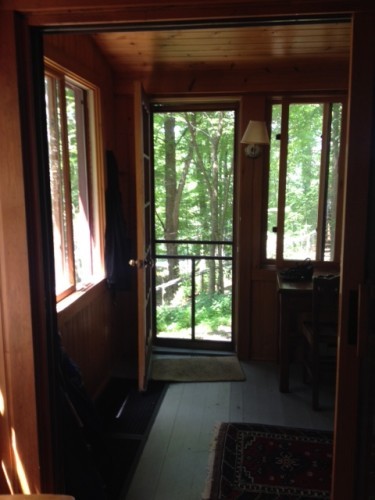 “Solitude is the soul’s holiday, an opportunity to stop doing for others and to surprise and delight ourselves instead.”
“Solitude is the soul’s holiday, an opportunity to stop doing for others and to surprise and delight ourselves instead.”
There comes a moment.
You love your life and the precious people in it. And yet, suddenly the very intimacy you cherish feels like a burden you can no longer carry. You want to see yourself as a person who is competent and sturdy and kind. And yet, today you are able to be none of these things.
You can’t plan one more meal or push the cart through the frigid produce aisles one more time or carry one more bag of groceries in from the car. You can’t cook another balanced dinner or sit at the table and have one more meaningful conversation. You can’t anticipate or meet one more need, or set one more thing to rights.
You want to sleep alone in a narrow, clean bed and wake up in silence and let things go their own way. You want to take a vacation from worrying and fretting and fixing. You want to have breakfast at ten and skip lunch and eat salad from the serving bowl for dinner — with your book propped in front of you. You want to take a walk at your own pace, slowly. You long for a conversation in which the only one you have to listen to is the small quiet voice inside, the voice that speaks without words.
You imagine what a relief it would be to spend a whole day without talking. Without cleaning or washing or weeding or folding anything. Without make-up, without good cheer, without a to-do list, without getting in the car, without reaching for your wallet or your phone or the dog leash or the sponge.
You wonder if anyone else hits this wall. The wall of too much. The hard unforgiving place of feeling crowded and tired and overwhelmed. Of knowing you simply cannot accomplish all that needs to be done. Or make good on all the promises you’ve made to others. Or live up to the expectations you’ve set for yourself.
You find yourself imagining solitude, craving it. The dark quiet cave of aloneness beckons.
And you think about where you might go, just for a little while, to privately fall apart and put yourself back together again, without causing anyone you love too much fuss or inconvenience.
You email a friend who has a cabin on a country road, the place you went once before to grieve the loss of a friend and to write the first, halting chapter of a book you weren’t sure you’d be able to finish. Yes, she responds moments later. Yes. Go.
You tell your husband, who knows better than anyone how frayed and fragile you are. Who worried when you burst into tears after breakfast for no reason, but whose hugs and rational words of advice just made you cry harder. Go, he says. I hope it’s what you need.
You undo some plans, cancel this and that, make a pot of soup to leave behind, water the houseplants, throw some things in a bag and drive. At the market you’ve never been to before, the items in your green plastic basket tell the story: cherries, an avocado, yogurt, kale, raspberries and blueberries and M&Ms. The food choices of a person who is not intending to feed anyone else.
You arrive at dusk in a downpour and lug your things up the twisty path. The cabin door is sticky but unlocked, like a magic place in a fairy tale. Everything you brought with you is soaked but it doesn’t matter. The rain has washed away some outer layer you were ready to shed anyway. Arriving drenched, with your hair plastered to your head and your feet squishing in your sandals, feels like a beginning. Already you are inhabiting your body in a different way — curious and raw, defenseless, hopeful.
Inside, the damp, musky scent of old wood, old seasons, summers past, gives rise to sharp childhood memories: a cabin rented long ago, the familiar textures of leisurely afternoons spent reading and dozing under old quilts while waves lapped a nearby shore. Solitude has always been your home territory. A daddy long-legs skitters across the floor. The rain pounds the roof. You open windows, put clothes on a shelf, line your wet shoes up. As darkness falls you feel lighter. Peaceful. Better.
In the morning, without any sort of plan, you walk up the road, going nowhere. Focus on today, you remind yourself. All is well, you say, to no one. And it is. With every step you are clearing a space, coming closer to a self you almost forgot you knew. The good news is, that self hasn’t abandoned you. She has been here all along, waiting patiently for you to turn away from all your busy comings and goings, to recognize her, greet her, and welcome her home.
The sun is shining and you are sweating and your legs are moving. You listen to the sounds of a summer day. Kids playing soccer at the boys’ camp on the lake. The encouraging shouts of counselors and the wild ruckus of competition. Further on, from a shed in a field: the sounds of an orchestra tuning up for rehearsal. A solo flute traveling up and down the scales. The breeze rustling leaves in the dense canopy of maples overhead. A lawnmower churning back and forth across a spanse of green. The drone of bees in a jumbled roadside garden, colorful as piñata. Everything has its wonders. You are here to pay attention.
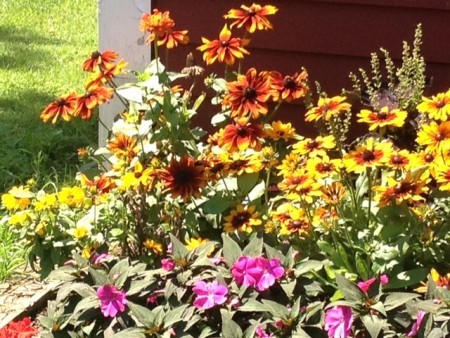 Alone, your life begins to feel like a choice again. You find yourself drawn into harmony with the sweet, easy flow of the day, unfolding according to its own rhythm. Slowly, something that was stuck deep inside begins to move. You ride the gentle currents of sadness, regret, joy, longing, acceptance. Surprised by tears, you lift your face to the sky and allow the sun to dry them.
Alone, your life begins to feel like a choice again. You find yourself drawn into harmony with the sweet, easy flow of the day, unfolding according to its own rhythm. Slowly, something that was stuck deep inside begins to move. You ride the gentle currents of sadness, regret, joy, longing, acceptance. Surprised by tears, you lift your face to the sky and allow the sun to dry them.
There is the necessary, satisfying work of serving others in all the places where you are loved and needed. But there is also this: the soul’s work, which you ignore at your peril. And so, for today anyway, you commit yourself to it fully: The journey inward to find your own truth. The stillness of your mind behind the noise of your doing. The willingness to see the beauty inside yourself, and to honor that. You are a little rusty and awkward in your quest. The privilege of solitude is also a skill that requires practice.
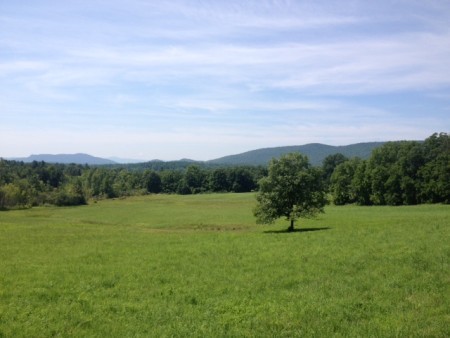 At the far end of a field, a granite bench awaits under the shade of a tree. The words “Sit a while” are in engraved across the top. You do. And you take in the view, the gentle, slumbering hills, the drifting veil of clouds. This, too, is a kind of compassion — resting, listening, waiting in the silence of your heart to feel the next step. There is a new energy moving in you. A reverence. You can do this. You can dive down, naked, into the sacred quiet. You can learn to be at ease here. To be grateful for these hidden treasures. In this secret, spacious place you remember something beyond the moment, a strength on which to build.
At the far end of a field, a granite bench awaits under the shade of a tree. The words “Sit a while” are in engraved across the top. You do. And you take in the view, the gentle, slumbering hills, the drifting veil of clouds. This, too, is a kind of compassion — resting, listening, waiting in the silence of your heart to feel the next step. There is a new energy moving in you. A reverence. You can do this. You can dive down, naked, into the sacred quiet. You can learn to be at ease here. To be grateful for these hidden treasures. In this secret, spacious place you remember something beyond the moment, a strength on which to build.
In a little while you will walk the long road back. You will return home tomorrow the same but different, still holding the hand of your wilder self, having touched for just a moment your own infinity.
The grace of God means something like:
Here is your life.
You might never have been, but you are,
because the party wouldn’t have been complete without you.
Here is the world.
Beautiful and terrible things will happen.
Don’t be afraid.
I am with you.
~ Frederick Buechner
The post solitude appeared first on Katrina Kenison.

